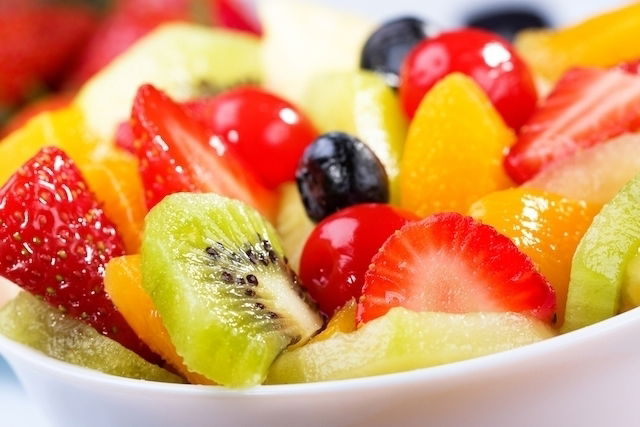Fruits for diabetics include tangerines, apples, pears, kiwis and oranges with pulp, as these are high in fiber. The fiber in these fruits slows down the rate at which sugar is absorbed into the body, helping to keep blood glucose levels regulated.
Fruits that are higher in carbohydrates, such as dried fruits, fruits canned in syrup and fruit juices, can still be consumed by diabetics, but in moderation, as these fruits have a lot of sugar and little fiber, which can increase glucose levels.

15 fruits good for diabetics
The fruits that best to consume with diabetes are:
- Strawberry
- Blackberry
- Tangerine
- Peach
- Pear
- Orange with pomace
- Apple
- Guava
- Avocado
- Kiwi
- Melon
- Mango
- Plum
- Blueberries
- Nectarine
It is important to note that all fresh, whole fruits are allowed to be consumed in diabetes, as long as they are consumed in moderation, with 2 to 4 portions a day. You should ideally eat these fruits with their peel and pulp whenever appropriate.
It's important to remember that fruit juice contains more sugar and less fiber than eating the whole fruit. For this reason, juice should not be the preferred way to consume fruit, as it contributes to hunger returning more quickly, as well as increasing blood sugar levels rapidly.
When is the best time to eat fruit?
It is important for diabetics to always eat fruit together with other foods, during or after lunch and dinner. The nutrients in these meals, such as fat, fiber and protein, help to slow down the rate at which the sugar in the fruit is absorbed into the blood.
You can also eat fruit that is rich in fiber, such as kiwi or oranges with the pulp, for breakfast or as a snack, accompanied by 1 serving of natural unsweetened yogurt, 1 tablespoon of flaxseed meal or 1 tablespoon of chia, for example.
Also recommended: Smoothies for Diabetics: 7 Natural Recipes to Manage Blood Sugar tuasaude.com/en/smoothies-for-diabeticsFruits that diabetics should avoid
Some fruits should be avoided by diabetics due to their high carbohydrate content or low fiber content include:
- Fruit canned in syrups, like plums, peaches and pineapple
- Fruit salad prepared with sugar or condensed milk
- Fruit jellies
- Fruit juices
Regular and frequent consumption of cantaloupe should also be avoided, as it easily raises blood sugar levels.
Are there any forbidden fruits for diabetics?
These above fruit are not necessarily forbidden for diabetics. However, their consumption will depend on other eating habits throughout the day and whether or not blood sugar levels are well-managed. They should also not be consumed on a regular basis.
Fruits to eat in moderation
Fruits that should be eaten in moderation are:
- Grapes
- Figs
- Papaya
- Banana
- Watermelon
- Tamarind
- Jackfruit
- Cape fruit
- Persimmon
- Tamarind
- Raisins
- Plums
- Dates
A good way to avoid a rapid rise in blood sugar is to eat these types of fruit together with high fiber foods, protein (such as meat, eggs or chicken) and good fats (such as nuts, cheese at lunch, dinner) or small meals.
Can diabetics eat nuts and dehydrated fruit?
Dried fruit, such as raisins, apricots and prunes, should be eaten in small quantities, because although they are smaller, they contain the same amount of sugar as fresh fruit. Just like fresh fruit, you can eat 2 to 3 servings of dried fruit per day. One serving is equivalent to about 30 g or 1 tablespoon of dried fruit.
You should also check the food label to see if the fruit has added sugar or just natural sugar.
Nuts, such as chestnuts, almonds and walnuts, have fewer carbohydrates than dried fruit, as well as good amounts of fiber, protein and good fats, which promote optimal blood glucose levels and help prevent diseases such as atherosclerosis and heart attacks. The recommended amount of nuts per day is approximately 30 g, which is equivalent to 1 handful.






























